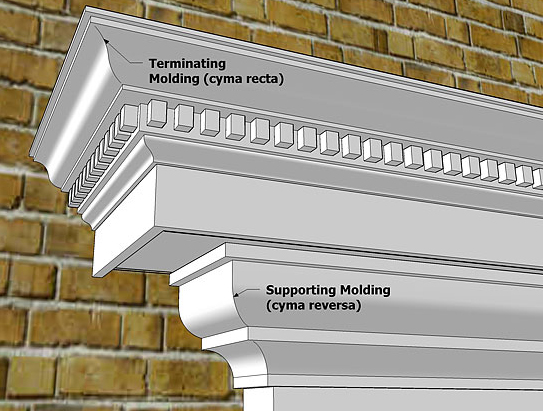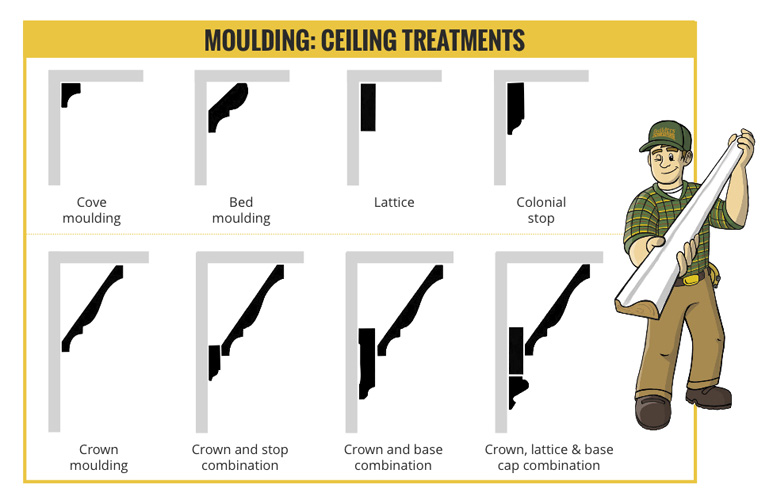Are you planning a home improvement project and feeling overwhelmed by all the trim choices available? You’re not alone.
When it comes to enhancing the elegance of a room, the details matter, and this is where molding comes into play. Two popular options are bed molding and crown molding, but how do you decide which one is right for your space?
Imagine walking into a room that instantly feels more sophisticated and complete. That’s the power of the right molding. But there’s more to these options than just aesthetics. Each type of molding serves a different purpose and can transform your room in unique ways. By understanding the differences between bed molding and crown molding, you can make an informed decision that elevates your interior design without unnecessary frustration. We’ll break down the key differences between bed molding and crown molding, so you can confidently choose the perfect trim for your home. Whether you’re renovating or just curious about design details, keep reading to discover how the right molding choice can change the entire look and feel of your space.

Credit: www.thisiscarpentry.com
Definition Of Bed Molding
Bed molding is a type of decorative trim. It enhances the look of walls and ceilings. Unlike crown molding, which sits at the top, bed molding is smaller. It serves as a transitional piece. It provides a subtle flair to spaces. Bed molding is often placed where the ceiling meets the wall. It can also be used on furniture edges. This molding style offers elegance. It adds depth without overwhelming a room.
What Is Bed Molding?
Bed molding is a form of trim. It’s used to create a seamless transition. This transition is between the wall and ceiling. It usually features simple designs. It can be curved or angular. Its main purpose is decorative. It also hides imperfections. These imperfections are where the ceiling meets the wall.
Materials Used In Bed Molding
Common materials for bed molding include wood and plaster. Wood is traditional. It offers warmth and charm. Plaster is versatile and durable. It works well in modern spaces. Some moldings use MDF. MDF stands for medium-density fiberboard. It’s cost-effective and easy to paint.
Applications Of Bed Molding
Bed molding is used in various settings. It’s found in homes and offices. It decorates ceilings, walls, and furniture. It can be used in kitchens and living rooms. It adds subtle elegance to any space. It’s also popular in historical buildings.
Benefits Of Bed Molding
Bed molding enhances interior design. It adds depth to rooms. It creates a polished look. It also helps hide flaws. Flaws can be gaps or uneven surfaces. It’s easy to install. It’s less expensive than crown molding. It suits both traditional and modern styles.
Definition Of Crown Molding
Crown molding adds elegance and style to any room. It is a decorative trim placed between the ceiling and walls. Traditionally, it was used to cover imperfections. Today, it is an aesthetic choice that enhances architectural details. Crown molding comes in various materials, including wood, plaster, and polyurethane. Each material offers unique benefits and visual appeal.
What Is Crown Molding?
Crown molding is a type of decorative trim. It is installed at the junction of walls and ceilings. This molding creates a smooth transition between surfaces. Its origins date back to ancient Greece. Then, it was crafted from marble. Modern versions are more affordable and versatile.
Materials Used In Crown Molding
Wood is the most traditional material for crown molding. It offers a classic and warm appearance. Plaster is another option, suitable for intricate designs. Polyurethane is lightweight and easy to install. It mimics the look of wood or plaster. Each material suits different tastes and budgets.
Benefits Of Crown Molding
Crown molding enhances the visual height of a room. It adds character and detail to plain walls. This trim can cover gaps and imperfections. It brings a polished look to interiors. Crown molding can increase a home’s value. It is a cost-effective way to upgrade decor.
Design And Aesthetic Features
When you’re planning a home makeover, moldings can significantly impact your interior design. Bed molding and crown molding are two popular choices, each offering unique design and aesthetic features. Let’s dive into the visual appeal of each to help you decide which best suits your style.
Visual Appeal Of Bed Molding
Bed molding offers a subtle yet effective way to enhance your rooms. This type of molding is typically less ornate than crown molding, making it ideal for a minimalist or modern aesthetic. Its sleek design adds a refined touch to any space.
Imagine walking into a room where the walls seamlessly blend into the ceiling with a delicate finish. That’s the charm of bed molding. It creates a smooth transition without overwhelming the space.
Consider your room’s proportions. If you have a smaller room, bed molding can add detail without making it feel cramped or cluttered. This molding style is about understated elegance.
Visual Appeal Of Crown Molding
Crown molding is like the statement piece of your room’s decor. Its intricate designs and curves can transform a space into something grand. If you want to add a touch of luxury, crown molding is your go-to.
Picture a dining room with crown molding framing the ceiling, giving an air of sophistication. It’s the kind of detail that guests notice and admire. Crown molding makes ceilings feel higher and rooms more spacious.
Yet, crown molding isn’t limited to traditional styles. There’s a wide range of designs available, from classic to contemporary. Think about the ambiance you want to create and let crown molding be the finishing flourish.
So, which molding style speaks to you and your home’s personality? Both offer unique visual appeals. Bed molding provides a subtle elegance, while crown molding makes a bold statement. Your choice will set the tone for your space’s character.
Functional Differences
Bed molding and crown molding are often confused because they both enhance the aesthetic appeal of a room. However, their differences go beyond appearance. Bed molding serves more functional purposes than crown molding. This distinction is crucial for homeowners deciding which type to install.
Bed molding is versatile. It is often used in cabinetry and furniture to provide subtle transitions. You might find it in places where walls meet ceilings in older homes. It’s not just decorative; it can hide minor imperfections where surfaces connect. If you’re looking to add a touch of elegance without overwhelming your space, bed molding is a gentle choice.
Ever noticed a seamless finish in your kitchen cabinetry? That’s likely bed molding at work. It’s also excellent for adding depth to flat surfaces, making them appear more polished. Consider using it for smaller spaces; it’s less intrusive and perfect for tight corners.
Crown molding is bold and makes a statement. It’s typically installed at the junction of walls and ceilings. Crown molding is the go-to choice for grand spaces like living rooms and dining areas. It can transform a room from ordinary to extraordinary, adding a touch of luxury that catches the eye.
Imagine walking into a room where the ceiling seems to float, creating a sense of height. Crown molding can achieve this effect, making rooms feel larger and more open. It’s also used to frame windows and doors, adding a dramatic flair. Are you looking to impress guests with your interior design? Crown molding might be your answer.
Have you ever considered how these moldings could change the feel of your home? Selecting the right one could be the key to achieving your desired aesthetic. What do you value more: subtle elegance or bold grandeur?
Installation Process
The installation of molding can transform a room’s appearance. Understanding the steps is crucial. Each type of molding has its own unique process. This guide will walk you through installing bed and crown molding. These steps ensure a smooth and efficient installation.
Installing Bed Molding
Installing bed molding is straightforward. Begin by measuring the wall’s length. Cut the molding to fit these measurements. Use a miter saw for precise angles. Ensure the corners match. Before attaching, paint or stain the molding. This avoids messes on the wall later.
Attach the molding using a nail gun. Place nails at regular intervals for stability. Check alignment frequently. Use a level to ensure straight lines. If gaps appear, fill them with caulk. This gives a polished look. Allow the caulk to dry before painting over it.
Installing Crown Molding
Installing crown molding requires more precision. Measure the room’s perimeter first. Mark where the molding will sit. Cut the molding at a 45-degree angle. This ensures a seamless fit at corners. Support long pieces with an extra set of hands.
Use a nail gun for attachment. Start at one corner and work your way around. Press firmly against the ceiling and wall. Check the alignment with a level. Fill any gaps with caulk. For a professional finish, sand the edges lightly. Paint the molding for a cohesive look.

Credit: woodshms.com
Material Choices
Choosing between bed molding and crown molding involves understanding their distinct features. Bed molding offers a subtle decorative touch, often used where walls meet ceilings. Crown molding, larger and more ornate, enhances elegance in living spaces. Both add character, but their styles suit different design preferences.
Choosing the right material for your molding can significantly impact the look and feel of your space. Bed molding and crown molding each have their own set of common materials, and understanding these options can help you make the best choice for your home. Whether you’re a DIY enthusiast or planning to hire a professional, knowing the material differences is essential for achieving that perfect finish.Common Materials For Bed Molding
Bed molding often calls for materials that are easy to work with and install. Wood is a popular choice due to its versatility and classic appeal. You might find pine or oak in many homes because they can be easily painted or stained to match your decor. MDF (Medium-Density Fiberboard) is another option for those on a budget. It offers a smooth surface and is less expensive than solid wood. However, it might not be as durable in high-moisture areas. Polyurethane is a great choice if you want something lightweight and easy to install. It’s also resistant to moisture, making it suitable for bathrooms and kitchens. Have you considered how weather conditions might affect your chosen material?Common Materials For Crown Molding
When it comes to crown molding, plaster can provide an elegant, traditional look. It’s perfect for historic homes or anyone looking for a touch of sophistication. However, plaster can be more challenging to install and may require a professional. PVC (Polyvinyl Chloride) is an increasingly popular option. It’s water-resistant and ideal for rooms with high humidity like bathrooms. Plus, it’s easy to clean, which is something to consider if maintenance is a concern. Metal crown moldings are gaining traction for their modern appeal. They come in materials like aluminum and stainless steel and add a sleek, contemporary vibe to any room. Are you ready to make a bold statement with your molding choice? By understanding the material choices for both bed and crown moldings, you can better align your selections with your home’s needs and your personal style. What material resonates with your vision for your space?Cost Considerations
Choosing between bed molding and crown molding involves budget considerations. Each type has its cost factors. Understanding these can help you plan your project wisely. This section explores the cost aspects of both moldings.
Cost Factors For Bed Molding
Bed molding typically costs less than crown molding. Its simple design requires less material. Installation is usually quicker, reducing labor costs. Bed molding is ideal for tight budgets. Material choice affects the price. Wood is pricier than MDF or PVC. Choosing paint-grade materials can save money.
Cost Factors For Crown Molding
Crown molding often involves higher expenses. Its complex designs need more material. Installation takes longer, increasing labor costs. Crown molding adds elegance to any room. The material choice impacts overall costs. Hardwood options are more expensive. Paint-grade alternatives are budget-friendly. Intricate designs add to the expense.
Choosing The Right Molding
Choosing between bed molding and crown molding enhances room design. Bed molding offers subtle elegance, fitting smaller spaces. Crown molding adds grandeur, perfect for high ceilings, creating a stately look. Both types highlight architectural features beautifully.
Choosing the right molding for your home can transform an ordinary room into an extraordinary space. Bed molding and crown molding each bring their own set of aesthetic and functional benefits. Understanding these differences can help you make an informed decision that aligns with your design goals and personal taste.Factors To Consider
When selecting molding, think about the room’s purpose. Is it a high-traffic area like the living room or a serene space such as a bedroom? Consider the ceiling height. Crown molding often requires higher ceilings to avoid making the room feel cramped. Budget is another key factor. Bed molding can be a cost-effective solution without sacrificing style. Material choice also plays a significant role. Wood, polyurethane, and MDF each offer different looks and durability levels. Do you want a bold statement or a subtle accent? Your choice will guide the design’s impact on the room.Matching Molding To Interior Design
Your home’s overall design theme should guide your molding choice. Modern interiors may benefit from sleek, simple bed molding. Traditional or classical styles often pair well with the ornate detail of crown molding. Color coordination is crucial. Whether you choose to paint or stain, ensure it complements other elements in the room. Think about the existing furniture and decor. Molding can either blend seamlessly or provide contrast. Personal experience taught me that mismatched styles can disrupt a room’s harmony. I once chose an elaborate crown molding for a minimalist space, and it felt out of place. Have you considered how molding interacts with natural light in your room? Different profiles cast unique shadows, adding depth and interest. What’s your ultimate goal with your space? Answering this will help guide your decision. Choosing the right molding isn’t just about aesthetics; it’s about creating a space that feels like home to you.Popular Trends
Popular trends in home decor often feature intricate moldings. Bed molding and crown molding are two favorites. They add elegance and style to any room. Trends in these moldings evolve with design preferences. Let’s explore what’s current in bed molding and crown molding.
Current Trends In Bed Molding
Bed molding is subtle yet stylish. It has gained popularity for its clean lines. Many homeowners opt for it in modern interiors. Light colors are trending in bed molding designs. They brighten the room and create a spacious feel. Textures are also in demand. They add depth and interest to walls. This molding is perfect for those who prefer minimalistic design.
Current Trends In Crown Molding
Crown molding is known for its classic beauty. It remains popular in traditional and contemporary homes. Bold colors are trending in crown molding. They create a striking contrast with ceilings. Intricate designs are also making waves. They add a touch of sophistication to any space. Crown molding enhances room aesthetics with its elegance.

Credit: builders-surplus.com
Frequently Asked Questions
What Is The Main Difference Between Bed Molding And Crown Molding?
Bed molding is smaller. It usually decorates the area between the wall and ceiling. Crown molding is larger and more decorative.
Can Bed Molding Be Used As Crown Molding?
Yes, but it’s less decorative. Bed molding is simpler and typically used for smaller spaces.
Which Is More Expensive, Bed Molding Or Crown Molding?
Crown molding is usually more costly. It often uses more detailed designs and requires more material.
Is Crown Molding Suitable For Every Room?
Not always. It suits formal spaces like living rooms. Small rooms might look crowded with crown molding.
Does Bed Molding Add Value To A Home?
It can. Bed molding offers a simple, finished look. It adds subtle detail to interiors.
Conclusion
Choosing between bed molding and crown molding depends on your style preference. Bed molding offers a subtle look, ideal for understated elegance. Crown molding stands out, providing a bold decorative touch. Both options enhance room aesthetics beautifully. Consider room height and architectural style when deciding.
Installation ease and cost may also influence your choice. Whether you prefer the simplicity of bed molding or the grandeur of crown molding, both add charm. They enrich your space, creating a refined atmosphere. Choose what suits your taste and complements your home best.
Enjoy the transformation molding brings to your interiors.




